When it comes to traveling to Sapa, Cuong believes that many of you are familiar with some well-known villages of ethnic people such as Cat Cat village, Ta Van village. However, Ta Phin village is less known because it is one of the farthest tourist destinations from Sapa, located at the foot of Hoang Lien Son mountain range. Due to its remote location and fewer tourists compared to the other two villages, Ta Phin village still retains its pristine scenery and the local ethnic people here preserve the richest cultural identity. That’s why it encourages young travelers to explore, right! Today, Cuong will review in detail the most interesting points in Ta Phin village for those who are preparing to travel to Sapa. You won’t find a more specific and detailed review of Ta Phin village than Cuong’s! Stay tuned!
Where is Ta Phin village in Sapa?
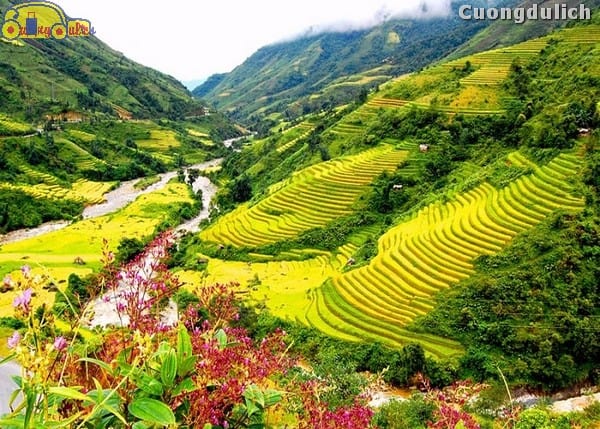
Ta Phin village is located about 12km from Sapa town, slightly to the northeast. This is the residential area of Dao and H’mong ethnic groups. Ta Phin village is close to the limestone range, a branch of Hoang Lien Son mountain, about 1km from the Ta Phin commune People’s Committee headquarters.
How to get to Ta Phin village in Sapa
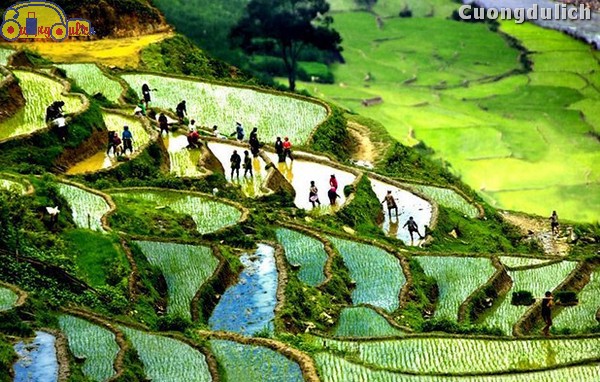
If you start from Ban Ta Phin from the center of Sapa town, you just need to follow the national highway 4D for about 5km. Then, continue to turn left to the ticket gate of Ban Ta Phin. Here, you buy a ticket to enter the village. From here, if you want to reach the head of the village, you need to walk about 7km.
Along the way to Ban Ta Phin, tourists will be enchanted by the beautiful and peaceful natural scenery of the Northwest mountainous forest region with terraced fields spreading across the hillsides and mountainsides. In the distance are blurry green mountain ranges, hidden in the shimmering mist. Here and there are dotted with traditional stilt houses and thatched roofs of ethnic people, along with lush green cornfields.
Just to paint a romantic picture for you, in reality, the road to Ban Ta Phin is quite rugged, you have to overcome steep and winding mountain passes, sometimes the road is so bumpy that it feels like your butt is bouncing. There are steep and narrow sections of road that are only enough for one vehicle, so vehicles going in opposite directions have to hug the mountain wall to pass each other. Therefore, Cuong advises that if you want to visit Ban Ta Phin, it’s best to ask the local motorbike taxi drivers from the center of Sapa to take you there. For those who want to rent a vehicle to explore the village, Cuong thinks the road is quite difficult and easy to get lost because it’s very winding. But for backpackers, every road is worth traveling, every journey is completed, so there’s nothing to worry about! If you go by car, the vehicle can now reach the center of Ta Phin commune.
Cost of visiting Ban Ta Phin Sapa
As Cuong mentioned above, Ban Ta Phin charges an entrance fee for visitors, but the price is very affordable, only 20k/person. Compared to more touristy villages like Cat Cat (50k/person) or Ta Van (75k/person), this price is quite cheap.
For those who choose to take a motorbike taxi from the center of Sapa to Ban Ta Phin, the price for one trip according to Cuong’s research ranges from 120-150k. As for those who choose to take a taxi or rent a car to Ban Ta Phin, the price is around 500-700k/day.
When you arrive at Ban Ta Phin, if you bring your own food and drinks, you won’t have to spend money on meals. But if you want to enjoy local cuisine, you can visit restaurants and eateries along the road. With about 500k for a group of 4 people, Cuong thinks it’s enough for a sumptuous lunch with a plate of grilled pork, a plate of village chicken, and stir-fried water spinach.
If you want to stay overnight in Ban Ta Phin for a few days of exploration, you can stay at homestays with a very affordable price of around 200k/night.
Adding up all the expenses, Cuong thinks you can have a few enjoyable days exploring every corner of Ban Ta Phin for only about 1.2 million VND. In general, the cost of traveling to Sapa is quite cheap compared to other tourist destinations in the country.
What makes Ban Ta Phin Sapa so captivating for tourists?
1. Terraced fields
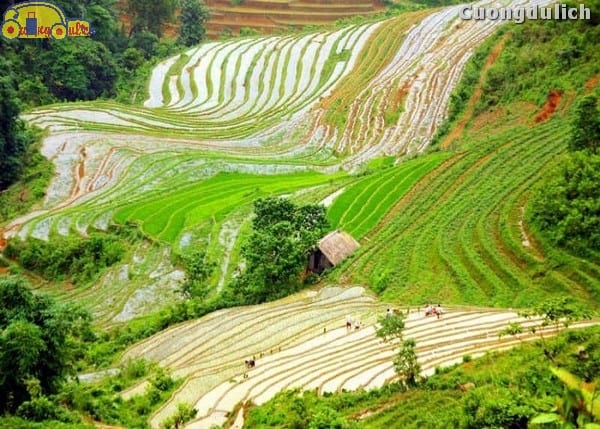
Just like many other areas in Sapa, the characteristic feature of the farming fields of the ethnic people in Ta Phin village is the terraced fields. The terraced fields wind and spread out before Cuong’s eyes like strips of silk. When Cuong visited Ta Phin village in Sapa, it was the season when the locals were watering the fields. The rows of terraced fields layer upon layer closely resemble silver streams, filled with abundant water, reflecting the sky and the landscape. Here are the hardworking farmers.
Before Cuong’s eyes appeared a scene of labor and life that is very different and unique to the mountainous forests of the Northwest, a blend of enthusiastic labor and the tranquil peace within the scenery and the vast expanse of the mountains. Standing on the hillside looking down at the terraced fields stretching down to the valley, Cuong seemed to forget all the weariness of daily life, forgetting all the worries and busyness, truly immersed in nature and finding peace in the soul.
2. Ta Phin Cave

For those who enjoy exploring caves like in Ha Long Bay or Trang An, Cuong believes you will also enjoy exploring the Tả Phìn cave. The Tả Phìn cave, also known by locals as Ti Ổ Cẩm, is located in a mountain range branching off from the Hoàng Liên Sơn range. The cave is about 5m high and 3m wide.
From the cave entrance down to the depths of the earth, only one person can fit through, and you have to walk about 30m further. As you go deeper, the cave becomes narrower and more eerie. It may feel a bit scary, but in reality, it is full of excitement and adventure. You won’t know what awaits you ahead until you come across huge stalactites in various shapes. The rock walls on both sides have many crevices and the mountain twists and turns, but eventually leads back to the cave entrance. Visitors who follow the path along the large mountain wall will feel the ups and downs, the wide and narrow sections where only one person can pass through.
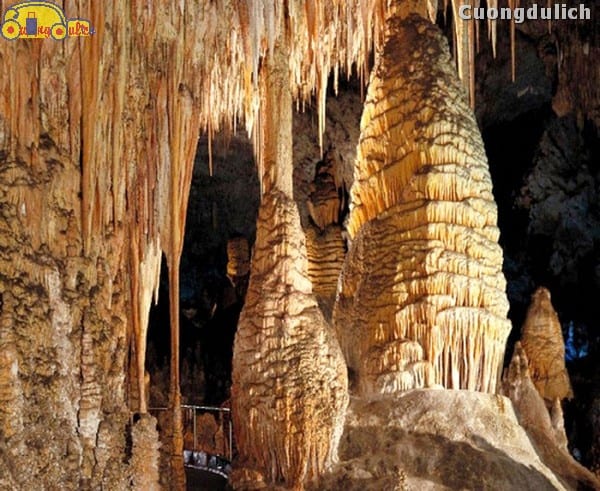
Following the path along the cliff, one feels as if climbing up the mountain wall, the road winding up and down, with some parts bulging out, some resembling a rock that looks like a woman carrying a child, some like naked fairies bathing, some like a giant rice tray, some like rows of smooth white columns hanging down from the roof, forming a twisting, undulating row of “stalactites,” shimmering in emerald green. That day, Cuong and his friends explored this Tả Phìn cave together, playing around inside, looking up to admire the rock formations and imagining various shapes. This experience reminded Cuong of his childhood when he used to look up at the flying clouds in the sky and see clouds in various shapes. It had been a long time since he had revisited his childhood memories like that.
Inside the cave, you can see various stalactites hanging down in different shapes, sparking interesting associations. In the misty space, shining a light to search for the mysteries hidden in the cave is an unforgettable experience. Water droplets seeping through the rocks, flowing down from the mountain walls for thousands of years, dripping onto the stalactites, creating a serene atmosphere in the cave, with the sound of dripping water echoing mysteriously.
Deeper inside the cave, you will see a large rock lying slightly tilted, with chicken footprints engraved on the stone floor, and on the right side of the rock, there are grooves that look like horse hooves. On the opposite wall, there are French inscriptions carved with a hard object, still readable despite being covered in dust from time. Cuong truly believes that the Tả Phìn cave holds historical, archaeological, research, and significant tourism values, with great potential for future exploration.
3. Tả Phìn Monastery
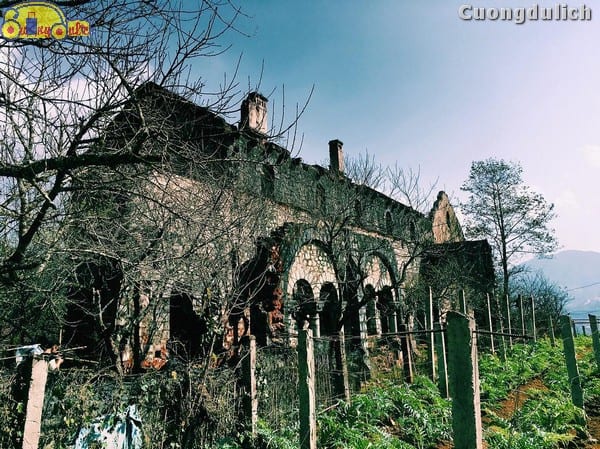
The Tả Phìn Monastery was built in 1942. This was a place for female Christian monks to live and practice for many years before leaving for Hanoi in 1945 due to unstable security conditions. Since then, the monastery has been abandoned and turned into ruins, but because it was built with solid onyx stones, the walls and columns still exist to this day and have become a very popular check-in spot for young people.
The monastery consists of a west-facing horizontal house, a small staircase, and a basement underground. In front of the building is a wide, long corridor that has aged over time. This horizontal house is the residence and activity area for the female monks. Additionally, to the right of the building is where food, supplies, and the monastery’s kitchen are stored. Currently, this monastery has deteriorated significantly. The entire roof is gone, leaving only moss-covered ancient walls.
It is the reason why this place attracts many young people rushing to take photos for check-ins because the Tả Phìn Monastery evokes a nostalgic feeling with its old moss-covered walls that have stood the test of time. Taking photos at the Tả Phìn Monastery feels like capturing images at an ancient Western building, as the monastery was built to serve female monks and thus carries Western architecture. Visiting here, Cuong guarantees you will have some deeply profound photos in this ancient, nostalgic setting. That day wandering around the Tả Phìn Monastery, Cuong was reminded of an old poem from school days, “The old threshold, the shadow of the ancient sun,” which perfectly fits the scenery there.
4. Immerse yourself in the rich cultural life of the ethnic people
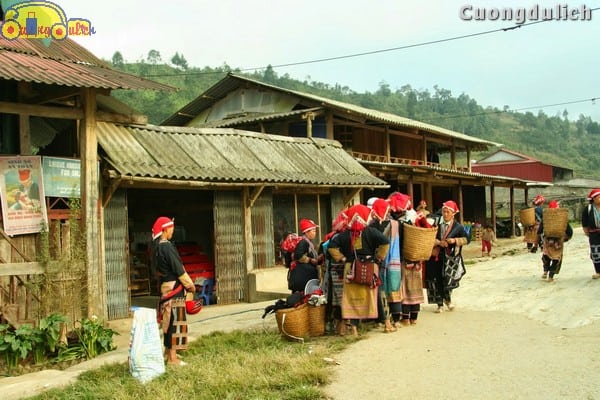
When you arrive at the head of Ta Phin village, you will be welcomed by the gentle and friendly local people. They will warmly greet you, ask where you are from, and inquire about where you want to go. Then they will show you the way and invite you to see the items they are selling, encouraging you to buy this or that. They will say this bracelet looks beautiful on you, or this scarf suits you well… Here and there, you will see young Hmong and Dao women in colorful traditional costumes, smiling shyly when they see strangers.
There are also older women selling goods who are quite playful, asking your age, where you are from, complimenting your beauty and everything you wear. If you are with your partner, they will praise you for looking alike, saying you make a beautiful couple… These simple words, though not very fluent in the Kinh language, will make your face light up with joy. Whether they are speaking sincerely or just complimenting to make a sale, being praised for being pretty and beautiful will make you feel elated and as if you are floating on cloud nine.
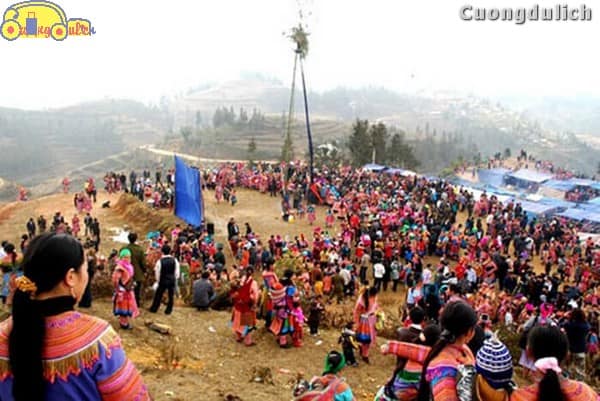
People here are very friendly. If you don’t have an itinerary and a place to stay, some locals will guide you on where to explore all the interesting and beautiful places in Ta Phin village in detail, and even invite you to their homes for meals and rest. Staying with the local people here is also very interesting, you will get to cook together, listen to stories about the culture and life of the people here. Traveling and engaging with the locals, sitting by the warm fire to dispel the cold of the mountains, sipping corn wine, and listening to the elders tell ancient stories, what could be better than that. I guarantee that when you leave Ta Phin village and head down the mountain, you will feel like a true Hmong or Dao person.
The customs and traditions of the Hmong ethnic people are staged as performances for visitors to admire. These include wedding ceremonies, love duets, village rituals, and ceremonies to dispel bad luck…
Almost every visitor is impressed by the beautiful Dao girls in their colorful traditional costumes. The main ethnic groups living in Ta Phin village are the H’mong and the Red Dao. Despite living close to each other, you will see that each ethnic group has its own unique cultural characteristics without mixing. You will notice the distinct differences between the Red Dao and the H’mong in terms of house architecture, house decorations, writing, clothing, jewelry, and especially customs and festivals.
When you come here, you will have the opportunity to learn about the daily life and customs of the ethnic people, such as the Bai Tram dance ritual, catching three balls, wedding ceremonies, bell dancing, love duets… In addition, the Hmong people have ceremonies to dispel bad luck, oath-taking ceremonies, village rituals, and especially the Gau Tao festival. In these festivals, there are customs that you have never seen before. That’s why many visitors are excited to come here and discover many new things.
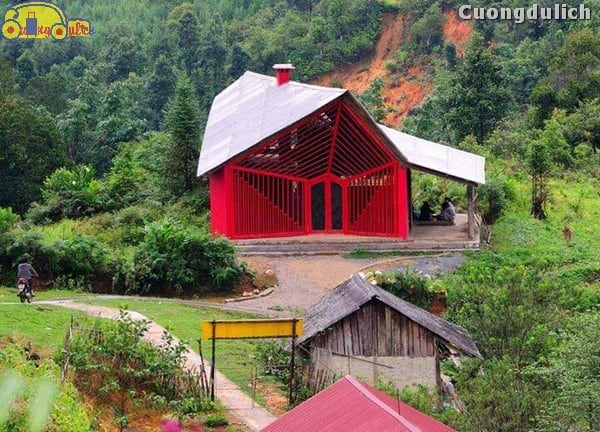
Right in the center of Tả Phìn village in Sapa is a community house painted in a vibrant red color that stands out in the surrounding landscape. This place has been rebuilt with architectural inspiration from the traditional scarf of the Red Dao people. It serves as a common area for tourists and locals to gather. Here, tourists can listen and learn more about the cultural life of the highland people. Hearing about new and interesting things will surely be a fun experience, won’t it?
5. Brocade Weaving Village
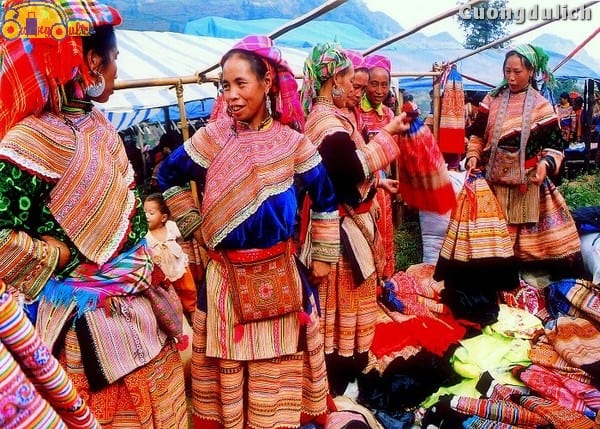
For the people of this ethnic group, brocade is not only used to serve daily life but also carries a sacred meaning, as a token of love or dowry on the wedding day. For the H’Mong or Dao ethnic groups here, girls must know how to embroider to get married. So from a young age, girls are taught to sew, weave fabric, embroider flowers… The brocade of Ta Phin is also ordered by many places in the country to sell to customers and export to markets such as the United States, France, Denmark…
The brocade craft village of Ta Phin is famous for its diverse and colorful products that are truly eye-catching. These products are entirely made by the skilled hands of Dao and H’Mong women. The floral patterns created on the various products such as birds, flowers… reflect the mountainous nature intertwined with the daily life of the people. You can easily find souvenir gifts to remember the highland market in Sapa when you return to the city, such as traditional costumes, cute bracelets, brocade bags, scarves…
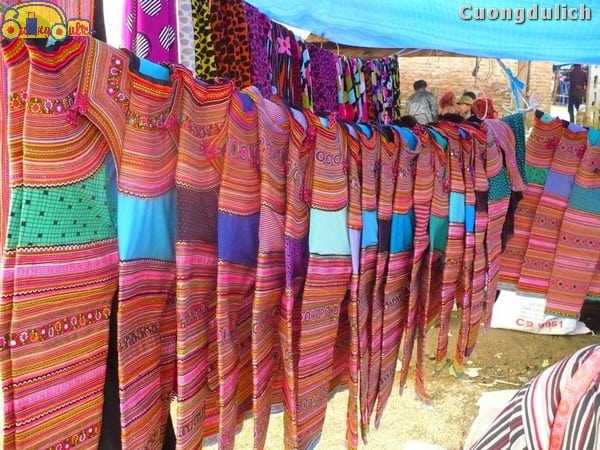
When wandering around the paths in Ta Phin village, you can easily come across local women sitting by the loom weaving brocade with skillful hands. In front of that scene, you can feel the immense peace amidst the mountainous landscape.
Especially, Ta Phin village in Sapa is also famous for many other traditional handicraft villages. For example, the silver inlay craft and forging craft. Therefore, tourists can buy unique silver jewelry products such as bracelets, rings, necklaces…
6. Silver inlay craft
The Red Dao people in Ta Chai village, Ta Phin are quite famous for their silver inlay craft. The Mong, Tay, and Thai residents often buy and use silver inlaid items – jewelry made by the Red Dao people. The material for making jewelry is coins made of white silver. The tools for making silver jewelry are mostly from the furnace, from the bellows to the silver cooking pot, casting molds, and engraving tools. In the life of the Red Dao people, the “value” of the girls is shown in the silver jewelry.
7. Forging craft
This is a traditional handicraft that still exists to this day among the Red Dao and Mong people. The production process is done manually, building furnaces with clay, burning fire with firewood, putting iron and steel into the red furnace, one person pulls the bellows, one person hammers to shape the necessary tools for production and daily life.
8. The famous herbal bath of the Red Dao people
In addition to admiring the brocade products, tourists can easily come across Red Dao women carrying on their backs baskets full of leaves or the verandas of ethnic people filled with leaves. The Red Dao people have a very long-standing traditional custom of bathing with herbal leaves regularly, especially on the last days of the year, the end of the month. The meaning is to cleanse all the misfortunes of the old year, help the body feel refreshed, healthy to welcome the new year. This is quite similar to the custom of bathing with herbal water at the end of the year of the Kinh people, isn’t it!
These herbal leaves are directly picked from the forest by the people, washed, dried, and when needed, boiled with warm water and poured into the bath, soaking feet, steaming is very good. To have a quality bath, the Red Dao people can use 120 different types of herbs, at least more than 10 types of herbal leaves. If you want to try bathing with this herbal type, you can bathe right in the village at a very cheap price of only about 150k/time.
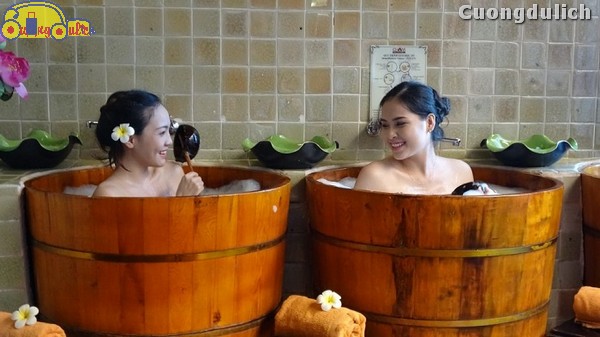
A wooden bath tub is made from pomu wood, with a natural wood scent, fragrant with herbal medicine scent, and the bath water is reddish-brown like Bordeaux wine. The water ripples, warm, making anyone who bathes in it feel mesmerized and praised.
The benefits of bathing with these herbal leaves have been scientifically proven by researchers at the University of Pharmacy. Bathing with leaves helps enhance vitality for men, helps women have smooth, glowing skin, helps the elderly improve sleep, helps children boost immunity and have healthier skin.
Especially, this herbal remedy is also used to treat conditions such as muscle, bone, and joint pain, flu, itching, constipation, abscesses, or to enhance physical strength for women after childbirth, for those recovering from illness. Laborers, tired after work, feel their bodies light and relaxed after bathing, their spirits refreshed, and their health restored.
The feeling of immersing oneself in warm water, the distinctive scent of herbal leaves, and Cuong’s fatigue after a day of trekking through forests, crossing passes and streams to reach Ban Ta Phin seems to disappear. Every muscle in the body relaxes, the whole body loosens up. After bathing, you feel truly refreshed, so why not try the traditional herbal leaf bath of the Red Dao people, renowned all the way to Hanoi with many herbal leaf bathing facilities. However, the most authentic must be in Ban Ta Phin, so if you have the chance to visit Ban Ta Phin, why not try the genuine herbal leaf bath of the Red Dao people!
9. What to eat in Ban Ta Phin?
In Ban Ta Phin, there are unique dishes with traditional flavors of the local people such as braised armpit pork, stir-fried village chicken with lemongrass, pork soup cooked with bamboo shoots and sour bamboo shoots. However, a companion of Cuong seems not to be very fond of the ethnic food. Luckily, Cuong brought along some light food so he didn’t go hungry. Some other friends who have traveled to Ban Ta Phin also commented that the food here is quite unique, not really suitable for the taste of most Kinh people and there are not many options, so you can bring food from Sapa town to still have a full meal and save a considerable amount!
10. Where to stay in Ban Ta Phin?
Similar to many other villages in Sapa such as Cat Cat village or Ta Van village, Ban Ta Phin now also has some homestays for tourists to stay right in the center of the village. Cuong would like to introduce you to some homestays with full amenities in Ban Ta Phin. Rest assured, you will have a good night’s sleep amidst the natural mountain forests!
Sapa homestay Ta May
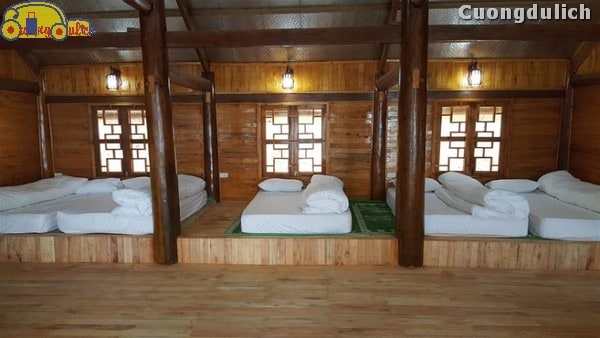
Located right on the mountainside, this homestay features a porch and a hot tub, built in the traditional style of the Dao people. Guests can enjoy meals at the restaurant. Additionally, you can cook your own meals in the shared kitchen. Here, guests can easily visit famous tourist spots such as Sapa Lake, Fansipan Legend cable car station…
Ta Phin Stone Garden Ecological
This resort is surrounded by lush greenery. It is a peaceful retreat, ideal for those looking to escape the hustle and bustle of life. The rooms are simply designed, with wooden floors, clothes racks, mosquito nets, and balconies overlooking the picturesque mountains.
Imagine waking up in the morning, opening your eyes to not skyscrapers tightly packed in the city, but lush green trees, listening to the sound of birds chirping, the flow of a stream, breathing in the scent of the countryside breeze, what could be more refreshing!
Cuong’s Experience Staying with a Red Dao Family
While staying in Ta Phin village, Cuong stayed with a local woman named Phan Phan Chau in team 4, Sả Séng hamlet, Ta Phin, Sapa. Chau welcomed us with a warm, genuine, and hospitable smile typical of the ethnic people. She invited us into her home, provided traditional clothes to wear, to prepare for a long day following her up the mountain, climbing a steep and muddy 6km path to collect 30 types of medicinal leaves for bathing.
Talking about the local attire, it may seem simple but is incredibly intricate. Chau shared with me that, in her opinion, learning to sew is even harder than learning to read and write. Starting at 7-8 years old, she had to learn from her grandmother and mother, then embroider until she was 18 and got married. She began learning to embroider from the back of a shirt to a pair of shirts, many pieces stitched together to form one shirt, a process that took about 4 months. Chau mentioned that some people took 2 years to complete one piece, some mothers took 2 months to embroider until their child turned 5. Each Red Dao woman would have about 2-3 sets. In the year before getting married, they had to stay at home for a year to embroider for both the wife and husband. The price of one set is around 6-8 million VND. Traditional clothes are worn all day to preserve the ethnic identity. Red scarves, pants, and black clothes dyed with bamboo, various dyes for 20-25 days to achieve black color, then dyed again with brown roots.
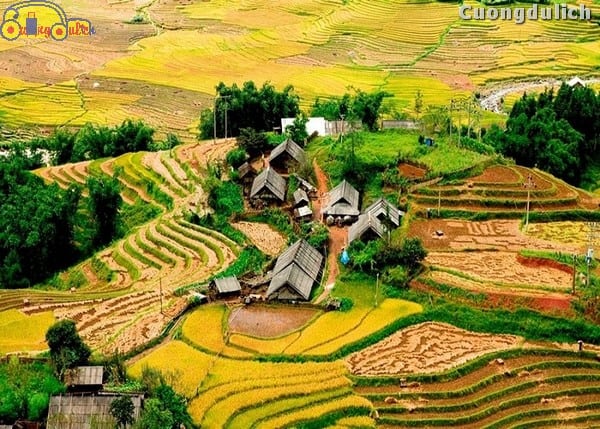
The next day, we followed Chau up the mountain to find medicinal leaves in the traditional bathing medicine of the Red Dao people. Chau said that 11 barrels of bathwater were the means of livelihood for her family before the harvest season. Early in the morning, Chau woke up, carried a bamboo basket up the mountain to pick medicinal leaves. Chau said that since ancient times, the Red Dao people have known how to use 120 types of traditional medicinal leaves to make bathwater, but each family has different ways of using and combining them. After crossing forests and mountains, picking about 30 types of leaves in the bamboo basket behind us, we descended the mountain with Chau.
As you can see, to have a barrel of leaf bathwater for us to soak in, the Red Dao people had to cross icy streams, trek tens of kilometers through the forest every day to bring back dozens of kilograms of leaves. Foreign visitors who bathe in the traditional medicinal leaves of the local people really enjoy it, praising endlessly the natural remedies that refresh and relax the mind and body. Chau also humorously recounted, “On the day I gave birth to my second child, after bathing in 2 pots of leaf water, I could carry my child to work in the fields comfortably after 15 days. I was as strong as an ox.”
Read more:
Extremely Detailed Review of 20 Sapa Travel Destinations for First-Time Sapa Visitors
Top Outstanding Tourist Attractions in Sapa
10 Hottest Sapa Travel Destinations – Save Now to Avoid Regrets
Some Notes When Visiting Ta Phin Village
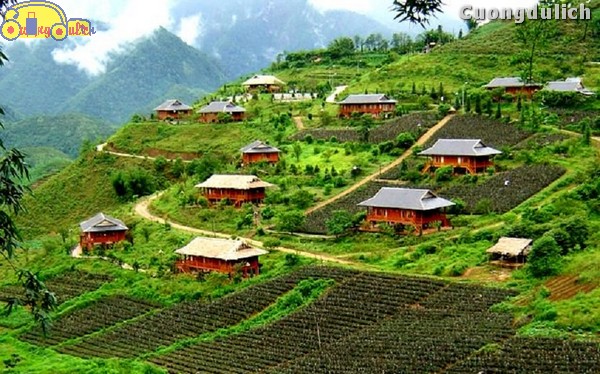
When traveling to Ta Phin village, there are some customs and rules that you need to remember for your trip to be smooth and enjoyable as follows:
According to the beliefs of the local ethnic people, guests who want to visit a house must follow the guidance of the host. The Hmong people’s houses usually have a large pillar buried deep in the ground and reaching the roof of the house. This is called the “cột cái,” where evil spirits reside, and you are not allowed to hang clothes or lean against that pillar.
The central area of the house is the worship area, so guests are not allowed to sit there.
The head of the table is reserved for the parents, and guests are not allowed to sit there.
When the host offers you water or alcohol, if you do not want to drink, politely refuse instead of pushing the bowl away on the table. Only the shaman is allowed to do so to ward off evil spirits.
When entering the village, avoid wearing white clothes as it is the color of mourning, and do not whistle while sightseeing in the village. This is because the locals believe that the sound of whistling is a call for evil spirits to come to the village.
When sitting down to drink alcohol, socialize, and chat with the host, do not point your finger forward while speaking. It is considered disrespectful or condescending.
Since the road to Ta Phin village is mainly hilly and difficult to traverse, with many bumps and potholes, those planning to visit the village by motorbike should wear comfortable clothes for easy movement. Cuong suggests that girls should temporarily set aside their fancy high heels and opt for sneakers for easier sightseeing and exploring the village.
For those interested in exploring the Ta Phin caves, it is advisable to bring a flashlight as the caves are deep and dark. If you are afraid of getting lost, you can ask a local guide to accompany you on your cave exploration.
If you are worried about not liking the local food, you can prepare your own food from Sapa town to avoid hunger and still enjoy exploring the village.
If you want to try the traditional herbal bath service of the Red Dao people, do not bathe when you are too hungry or too full, and do not bathe for too long as it may make you feel dizzy. You should only soak in the herbal bath for 15-30 minutes, as the minerals are absorbed through the skin into the body. You do not need to rinse off with water after getting out of the tub, just dry off and put on your clothes. Some women with weak physical conditions have felt sleepy and dizzy after a short herbal bath with the Red Dao people. Many ethnic women and mothers are attentive and caring, preparing the bathwater for guests while chatting with them, to prevent guests from falling asleep and getting dizzy in the bath!
Places to visit near Ta Phin village in Sapa
1. Ta Van village
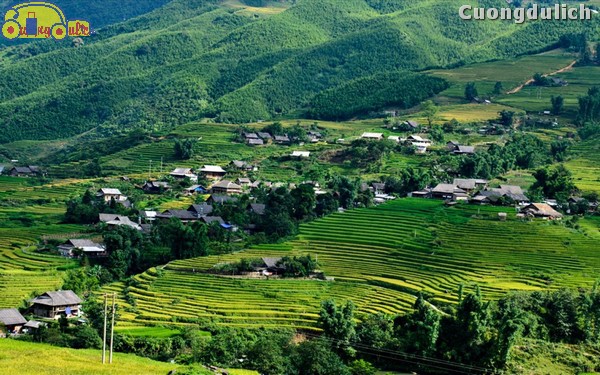
Located in Ta Van commune, Sapa district, Lao Cai province, 12 km from the center of Sapa town. Ta Van village is the living area of the H’mong ethnic people for a long time, besides, there are also Red Dao and Giay people living here. If you want to admire the beauty of the entire Muong Hoa valley, you must visit Ta Van village.
2. Muong Hoa Valley

Located in Hau Thao commune, about 12 km southeast of the center of Sapa town. From Sapa town, crossing a winding pass along the high mountains, tourists will reach the Muong Hoa valley. Visitors coming here will immerse themselves in the fresh air mixed with beautiful terraced fields, mountains hidden in white mist, glimpses of simple houses, large ancient trees, and beautiful nature. The Muong Hoa valley also has cool streams winding through the terraced fields. The Sapa ancient rock field is also located in the Muong Hoa valley. This archaeological site covers an area of about 8 square kilometers, discovered in 1925. The Sapa ancient rock field area is vast with nearly 200 rock blocks. What is special about these rock blocks is their extremely diverse and unique shapes such as terraced fields, humans, roads, and inscriptions.
3. Cat Cat Village
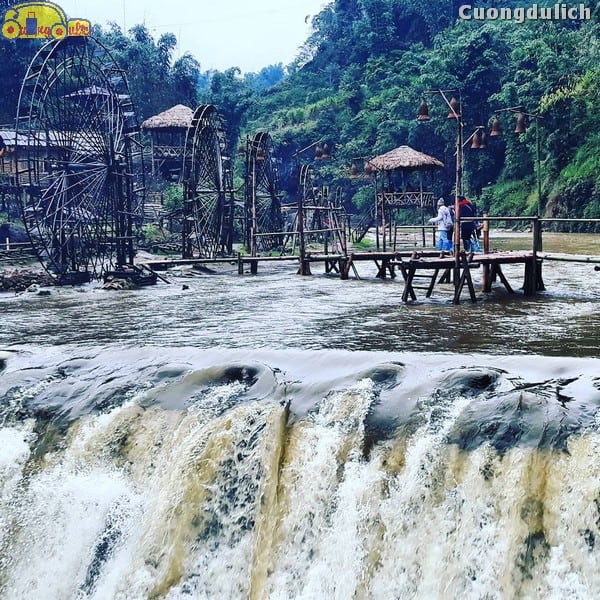
This is a small village in San Sả Hồ commune, Lào Cai. It is a highland area nestled amidst majestic mountains, with many local specialties such as corn wine, buffalo meat cooked on a stove, and various fruits. The road from Sapa town to Cát Cát village is about 2 km long. Along this road, you will be mesmerized by the vast and majestic landscape, with tall mountain ranges on one side and the Sapa valley on the other. This winding road is quite steep and located higher than Cát Cát village, allowing you to admire the entire village from above with houses nestled closely together among the trees. The central area of Cát Cát village features the Hoa stream with foamy white water, bamboo bridges swaying over the water, giant water mills, and rustic thatched roof houses. Further into the village is the pristine Cát Cát waterfall amidst rocky cliffs, resembling a desert oasis painting.
So Cuồng has introduced to you all the eating places, attractions, accommodations, and beautiful photo spots in Tả Phìn Sapa. When traveling to Sapa, you can choose all-inclusive Sapa tours such as 2-day 1-night Sapa tour so that the guides can provide more detailed information about the highlights and beauty of each Sapa tourist spot. There are many interesting things that Cuồng cannot fully describe. After visiting Tả Van Sapa, share your photos and experiences with Cuồng!
